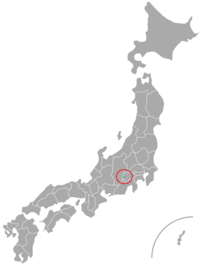| Narada dialect | |
|---|---|
| 奈良田方言 | |
 Approximate Narada dialect area. | |
| Native to | Japan |
| Region | Narada, Hayakawa, Yamanashi |
Japonic
| |
| Language codes | |
| ISO 639-3 | – |
The Narada dialect (Japanese: 奈良田方言 narada hogen) was a Japanese dialect spoken in the village of Narada, Hayakawa, located in Yamanashi Prefecture. Having formerly been isolated for centuries from surrounding areas, the dialect was considered a language island within the Tokai-Tosan dialect group, possessing various traits unique to Narada.
History
Narada was exceptionally isolated from ancient times; until the Meiji era the nearest settlement was over 2 hours away on foot. Villagers married exclusively amongst themselves, and interactions with outsiders were rare. [1] This environment fostered the persistence of older linguistic traits whilst also spurring the development of locally unique features. After World War II, various prefectural assemblies sought to have academic research conducted into the Narada dialect, with the resultant studies generating nationwide attention. Despite this, development of the nearby town of Hayakawa for electricity generation purposes, in addition to other factors, led to substantial changes in the lives of the residents. A following increase in emigration and the continued ageing of its population meant that by the 1970's, young speakers had all but vanished, placing the dialect at risk of extinction. In 1998, all speakers were aged 40 or over, and by 2020 the dialect had fallen out of everyday use. Despite its sharp decline, a recent study found that the pitch accent and grammar of the Japanese spoken by current residents is heavily influenced by the former dialect. [2]
Grammar
In the formerly long-secluded Narada, archaic grammar has been well preserved, with multiple unique traits.
Auxiliary verbs
- Nu (ぬ) and noo (のー) are used as negative auxiliary verbs. For example: kakanai (書かない don't write) = kakanoo (かかのー). No is thought to originate from -nafu (-なふ) in Central Old Japanese, and is also found in another language island, the Ikawa dialect.
- Too (とー) is used for the past tense of a verb. It is also used in other parts of Yamanashi Prefecture. [3] For example: nonda (飲んだ drank) = nondoo (のんどー).
- Usage of ra (ら) and zura (ずら) for conjecture and zaa (ざー) and zu (ず) for volition and persuasion is shared with the Koshu dialect.
Particles
- Sa (さ) is used as an equivalent to the directional particles ni (に) and he (へ) in standard Japanese. [4]
- Totte (とって) is used as an equivalent to the adversative conjunction keredo (けれど but, although). [5]
- De (で) is used as a cause/reason-expressing conjunction, whilst node (ので because, so) and kara (から same as node) are rarely used. [5]
References
- ^ 佐藤, 亮一 (2002). 消滅する方言音韻の研究調査研究 (in Japanese). 大阪学院大学情報学部.
- ^ 小西, いずみ (2021-06-04). 方言の島」山梨県奈良田の言語状況. UTokyo Repository (Thesis).
- ^ 飯豊, 毅一 (1983). 講座方言学 6 中部地方の方言 (in Japanese). 国書刊行会. pp. 128–129.
- ^ 飯豊, 毅一 (1983). 講座方言学 6 中部地方の方言 (in Japanese). 国書刊行会. p. 132.
- ^ a b 飯豊, 毅一 (1983). 講座方言学 6 中部地方の方言 (in Japanese). 国書刊行会. p. 133.